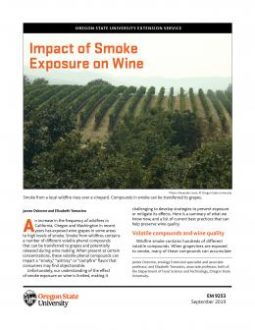Wildfire smoke can affect taste of winegrapes
An increase in the frequency of wildfires in California, Oregon and Washington in recent years has exposed winegrapes in some areas to high levels of smoke.
One of the affected areas has been Oregon’s fertile Willamette Valley, home to about half of the state’s 900-plus wineries. Smoke from wildfires contains a number of different volatile compounds that can be transferred to grapes and potentially released during winemaking.
When present at certain concentrations, these volatile compounds can impart a “smoky,” “ashtray” or “campfire” flavor that consumers may find objectionable. Unfortunately, an understanding of the effect of smoke exposure on wine is limited, making it challenging to develop strategies to prevent exposure or mitigate its effects.
In response, the Oregon Wine Research Institute (OWRI) in the College of Agricultural Sciences at Oregon State University formed a multi-disciplinary study team to seek information and develop solutions to this growing concern. The team includes sensory scientist Elizabeth Tomasino, flavor chemist Michael Qian, Extension enologist James Osborne, Extension viticulturists Patty Skinkis and Alex Levin and applied economist James Sterns. All are Oregon State University (OSU) faculty and OWRI core faculty members.
The group initially met in the fall of 2018 to define the problem, evaluate resources and current research, and begin to formulate a science-based approach to acquiring the necessary knowledge upon which recommendations can be based. This led to the development and submission of a number of grants to various funding agencies at the federal and state level.
In the late summer of 2020, wildfires ignited from northern California to east of Portland. Willamette Valley vineyards were blanketed by smoke for up to 10 days, leaving growers concerned for the well-being of their grapes and the plausibility of wineries purchasing this year’s crop. With testing labs in Oregon, Washington and California backlogged by the immense demand, OWRI researchers stepped to the plate. Tomasino, an associate professor of enology at OSU and one of the leaders of the wine smoke exposure team, developed a plan to start accepting grape and wine samples on Sept. 21, 2020.
From Sept. 21 to Nov. 2, 2020, OSU scientists processed 655 grape samples and used gas chromatography mass spectrometers to analyze the types and levels of compounds in them. At their peak, the scientists were running 60 samples a day and working 70-plus-hour weeks.
The testing program has two components. For the first part, Tomasino, Qian and Osborne accepted samples from wineries and grape growers for a chemical analysis of the grapes and wine to determine the best steps moving forward for their operations. The second component is a research project, funded by the Oregon Wine Board and the Erath Family Foundation, which supports research and education in the Oregon wine industry. For that project, OSU Extension agents collected 82 samples of smoke-exposed grapes from grape-growing regions throughout the state, including the Willamette Valley, southern Oregon, Columbia Gorge, and Milton-Freewater. Tomasino worked closely with Skinkis and Levin, to collect those samples over two weeks.
As a result, Oregon vineyardists were able to make more informed decisions for their operations. Growers Mike and Ruth Rava credited OSU with saving them $45,000, approximately 18% of their annual income from selling grapes, when tests revealed the wineries probably wouldn’t buy the grapes, making harvesting unnecessary.
 An Extension publication, “Impact of Smoke Exposure on Wine” has been developed that summarizes the current knowledge regarding smoke exposure and wine. This document will be continually updated in response to the latest research findings from the OWRI smoke exposure team. Currently, best practices to reduce risk of smoke characteristics in wine include:
An Extension publication, “Impact of Smoke Exposure on Wine” has been developed that summarizes the current knowledge regarding smoke exposure and wine. This document will be continually updated in response to the latest research findings from the OWRI smoke exposure team. Currently, best practices to reduce risk of smoke characteristics in wine include:
- Identifying and separating grape lots that are at risk of developing smoky wine characteristics.
- Preventing material other than grapes from getting into the fermenter, minimizing skin contact early in the process.
- Whole cluster pressing whites, using oak or oak chips to reduce the perception of smoky wine characteristics.
- Using yeast strains that may enhance fruity characteristics.
- Reverse osmosis and spinning cone treatment of wine can reduce the concentration of the free forms of the smoke aroma compounds, but smoky characteristics may reappear over time.
— Oregon State University










